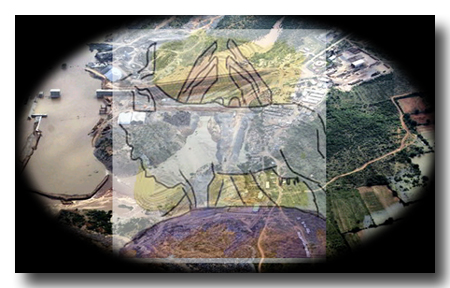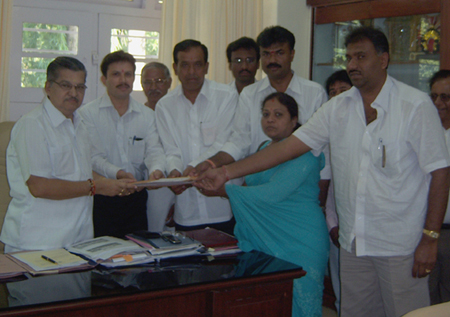India Won 7th Nobel Prize
on 7th October 2009..!

It sounds interesting. Because India won its 7th Nobel Prize on Wednesday, 7th Of October 2009. Yes! Indian born Venkatraman Ramakrishnan, a senior scientist at the MRC Laborartory of Molecular Biology at Cambridge, England, has won the 2009 Nobel Prize for Chemistry along with two others, the Nobel Committee announced on 7th October 2009.
The two other scientists, who shared the Nobel Prize in Chemistry with V Ramakrishnan are Thomas E Steitz (US) and Ada E Yonath (Israel). They all are working with MRC Laboratory of Molecular Biology at Cambridge.
Born in 1952 in Chidambaram, Tailnadu, Ramakrishnan shared the Nobel Prize with Thomas E Steitz (US) and Ada E Yonath (Israel) for their "studies of the structure and function of the ribosome".
Ramakrishnan earned his B.Sc. in Physics (1971) from Baroda University and his Ph.D. in Physics (1976) from Ohio University.
He moved into biology at the University of California, San Diego, where he took a year of classes, then conducted research with Dr Mauricio Montal, a membrane biochemist.
Let us remember the Great Sons of India who made Indians feel proud by winning the Nobel Prize which is the most respected award the world over.
Here is the list of Those Indians who won this prestigious award and let us salute them...
1) Rabindranath Tagore (1861 - 1941)
Nobel Prize for Literature (1913). Tagore was born and lived in Calcutta for most of his life. He was one of modern India's greatest poets and the composer of independent India's national anthem. In 1901 he founded his school, the Santiniketan, at Bolpur as a protest against the existing bad system of education.
The school was a great success and gave birth to Viswabharati. He was awarded the 1913 Nobel Prize in Literature for his work "Gitanjali"; for the English version, published in 1912. The noble citation stated that it was "because of his profoundly sensitive, fresh and beautiful verse, by which, with consummate skill, he has made his poetic thought, expressed in his own English words, a part of the literature of the West." In 1915, he was knighted by the British King George V. Tagore renounced his knighthood in 1919 following the Amritsar massacre or nearly 400 Indian demonstrators.
2) Sir C.V. Raman (Chandrasekhara Venkata Raman) (1888 - 1970).
Nobel Prize for Physics (1930). C V Raman was born on 7th Nov. 1888 in Thiruvanaikkaval, in the Trichy district of Tamil Nadu. He finished school by the age of eleven and by then he had already read the popular lectures of Tyndall, Faraday and Helmoltz.
He acquired his BA degree from the Presidency College, Madras, where he carried out original research in the college laboratory, publishing the results in the philosophical magazine. Then went to Calcutta and while he was there, he made enormous contributions to vibration, sound, musical instruments, ultrasonic, diffraction, photo electricity, colloidal particles, X-ray diffraction, magnetron, dielectrics, and the celebrated "RAMAN" effect which fetched him the Noble Prize in 1930.
He was the first Asian scientist to win the Nobel Prize. The Raman Effect occurs when a ray of incident light excites a molecule in the sample, which subsequently scatters the light. While most of this scattered light is of the same wavelength as the incident light, state (i.e. getting the molecule to vibrate). The Raman Effect is useful in the study of molecular energy levels, structure development, and multi component qualitative analysis.
3) Dr. Hargobind Khorana
Nobel Prize for Medicine and Physiology (1968)
Dr. Hargobind Khorana was born on 9th January 1922 at Raipur, Punjab (now in Pakistan). Dr. Khorana was responsible for producing the first man-made gene in his laboratory in the early seventies. This historic invention won him the Nobel Prize for Medicine in 1968 sharing it with Marshall Nuremberg and Robert Holley for interpreting the genetic code and analyzing its function in protein synthesis.
They all independently made contributions to the understanding of the genetic code and how it works in the cell. They established that this mother of all codes, the biological language common to all living organisms, is spelled out in three-letter words: each set of three nucleotides codes for a specific amino acid.
4) Dr. Subramaniam Chandrasekar
Nobel Prize for physics (1983)
Subramaniam Chandrashekhar was born on October 19, 1910 in Lahore, India (later part of Pakistan). He attended Presidency College from 1925 to 1930, following in the footsteps of his famous uncle, Sir C. V. Raman.
His work spanned over the understanding of the rotation of planets, stars, white dwarfs, neutron stars, black holes, galaxies, and clusters of galaxies. He won the Nobel Prize in 1983 for his theoretical work on stars and their evolution.
5) Mother Teresa (1910 - 1997)
Nobel Prize for peace (1979)
Born in 1910, Skoplje, Yugoslavia (then Turkey) and originally named Agnes Gonxha Bojaxhiu, Mother Teresa dedicated her life to helping the poor, the sick, and the dying around the world, particularly those in India, working through the Missionaries Of Charity in Calcutta. The Society of Missionaries has spread all over the world, including the former Soviet Union and Eastern European countries.
Missionaries of Charity provide effective help to the poorest of the poor in a number of countries in Asia, Africa, and Latin America, and they undertake relief work in the wake of natural catastrophes such as floods, epidemics, and famine, and for refugees. The order also has houses in North America, Europe and Australia, where they take care of the shut-ins, alcoholics, homeless, and AIDS sufferers. Mother Teresa died on September 5, 1997.
6) Dr. Amartya Sen
Nobel Prize for Economics (1998)
Amartya Sen (born 1933) was the first Indian to receive the Nobel Memorial Prize in Economics, awarded to him in 1998 for his work on welfare economics. He has made several key contributions to research in this field, such as to the axiomatic theory of social choice; the definitions of welfare and poverty indexes; and the empirical studies of famine.
All are linked by his interest in distributional issues and particularly in those most impoverished. Whereas Kenneth Arrow's "impossibility theorem" suggested that it was not possible to aggregate individual choices into a satisfactory choice for society as a whole, Sen showed that societies could find ways to alleviate such a poor outcome.
And the Seventh Man who won the Nobel Prize is Venkatraman Ramakrishnan.
There are few others connected to India also won the prestigious Nobel Prize.
They are:
1) Ronald Ross.
Born in Almora, India, in 1857 Ronald Ross was awarded the Nobel Prize in Physiology or Medicine in 1902 for his work on malaria.
He received many honours in addition to the Nobel Prize, and was given Honorary Membership of learned societies of most countries of Europe, and of many other continents. He got an honorary M.D. degree in Stockholm in 1910 at the centenary celebration of the Caroline Institute. Whilst his vivacity and single-minded search for truth caused friction with some people, he enjoyed a vast circle of friends in Europe, Asia and America who respected him for his personality as well as for his genius.
2) Rudyard Kipling (1865-1936).
Rudyard Kipling, born in Mumbai, 1865 (then Bombay in British India), was awarded the Nobel Prize in Literature in 1907.
He remains the youngest-ever recipient and the first English-language writer to receive the Prize. British writer, Kipling wrote novels, poems and short stories -- mostly set in India and Burma (now known as Myanmar).
3) Abdus Salam.
Abdus Salam (1926-1996), born in undivided Punjab and a citizen of Pakistan, and shared a Nobel Prize in Physics in 1979, with Steven Weinberg, for his work on electroweak unification, one of the important puzzles of modern theoretical physics. He was a visionary and an advocate of science in the third world. He founded the International Center for Theoretical Physics, in Trieste, Italy, which has nurtured world class physicists through workshops, fellowships and conferences.
4) V.S. Naipaul (1932- )
A British writer, V.S. Naipaul (Vidiadhar Surajprasad Naipaul) was born in 1932 in a family of north Indian descent living in Chaguanas, close to Port of Spain, on Trinidad.
He won the Nobel Prize in Literature in 2001. In awarding him the Prize, the Swedish Academy praised his work "for having united perceptive narrative and incorruptible scrutiny in works that compel us to see the presence of suppressed histories." The Nobel Committee added: "Naipaul is a modern philosopher, carrying on the tradition that started originally with Lettres persanes and Candide. In a vigilant style, which has been deservedly admired, he transforms rage into precision and allows events to speak with their own inherent irony."
The Committee also noted Naipaul's affinity with the Polish-born British author of Heart of Darkness, Joseph Conrad: "Naipaul is Conrad's heir as the annalist of the destinies of empires in the moral sense: what they do to human beings. His authority as a narrator is grounded in the memory of what others have forgotten, the history of the vanquished."
5)14th Dalai Lama
Tenzin Gyatso, 14th Dalai Lama ((Born on 6 July 1935 at Taktser, Amdo, northeastern Tibet).
Former Head of state of Tibet and active leader of Tibetan Resistance towards PRC. Escaped to India when the PRC took over Tibet. Although legally a citizen of Tibet and hence indirectly China, he is head of Tibetan Government in Exile which is stationed in India. He got Nobel Peace Prize in 1989 for efforts for Tibetan Freedom through Non-Violence and Spreading Global Peace through Buddhism. Also during Prize Distribution, Head of Prize Committee commented that the prize was a part of tribute to memory of Mahatma Gandhi. Tenzin travels widely, in an effort to promote peaceful ideals.











